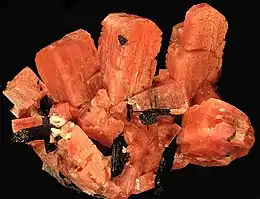| Serandite | |
|---|---|
 Serandite from Mont Saint-Hilaire, Quebec, Canada | |
| General | |
| Category | Inosilicates |
| Formula (repeating unit) | Na(Mn2+,Ca)2Si3O8(OH) |
| IMA symbol | Srd[1] |
| Strunz classification | 9.DG.05 |
| Dana classification | 65.2.1.5 |
| Crystal system | Triclinic |
| Crystal class | Pinacoidal (1) (same H-M symbol) |
| Space group | P1 |
| Unit cell | a = 7.683(1) Å, b = 6.889(1) Å c = 6.747(1) Å, α = 90.53(5)° β = 94.12(2)°, γ = 102.75(2)° Z = 2 |
| Identification | |
| Colour | salmon pink to orange |
| Twinning | Around [010] composition plane {100}, less commonly contact twin on {110} |
| Cleavage | Perfect on {001} and {100} |
| Fracture | Irregular, uneven |
| Tenacity | Brittle |
| Mohs scale hardness | 5 to 5.5 |
| Luster | Vitreous to greasy; fibrous aggregates are dull to silky[2] |
| Streak | White |
| Diaphaneity | Transparent, Translucent |
| Density | 3.34 g/cm3 (measured) |
| Optical properties | Biaxial (+) |
| Refractive index | nα = 1.668 nβ = 1.671 nγ = 1.703 |
| Birefringence | δ = 0.035 |
| 2V angle | 39° |
| Dispersion | r < v moderate |
| References | [3] |
Serandite[4] is a mineral with formula Na(Mn2+,Ca)2Si3O8(OH). The mineral was discovered in Guinea in 1931 and named for J. M. Sérand. Serandite is generally red, brown, black or colorless. The correct name lacks an accent.[5]
Description
Serandite is transparent to translucent and is normally salmon-pink, light pink, rose-red, orange, brown, black, or colorless; in thin section, it is colorless.[2] Octahedrally bonded Mn(II) is the primary contributor to the mineral's pink colors.[6]
Crystals of the mineral can be prismatic to acicular and elongated along [010], bladed, blocky, or tabular and flattened on {100}, occur as a radiating aggregate, or have massive habit.[2] Sérandite is a member of the wollastonite group and is the manganese analogue of pectolite.[3] It is sometimes used as a gemstone.[7]
History
Serandite was discovered on Rouma Island, part of the Los Islands in Guinea.[3] The mineral was described by À. Lacroix in the journal Comptes rendus hebdomadaires des séances de l'Académie des Sciences.[8] He named it sérandite in honor of J.M. Sérand, a mineral collector who helped in the collection of the mineral.[3]
Occurrence and distribution
Serandite has been found in Australia, Brazil, Canada, Guinea, Italy, Japan, Namibia, Norway, Russia, South Africa, and the United States.[3] The type material is held at the National Museum of Natural History in Washington, D.C.[2]
At Mont Saint-Hilaire, Quebec, serandite occurs in sodalite xenoliths and pegmatites cutting syenites within an intrusive alkalic gabbro-syenite complex. In Point of Rocks, New Mexico, it occurs in vugs in phonolite. At the Tumannoe deposit in Russia, serandite occurs in a manganese rich deposit associated with volcanic rocks and terrigenous (non-marine) sediments which has been altered by contact metamorphism.[2]
Serandite has been found in association with aegirine, analcime, arfvedsonite, astrophyllite, eudialyte, fluorite, leucophanite, mangan-neptunite, microcline, nepheline, sodalite, and villiaumite.[2]
References
- ↑ Warr, L.N. (2021). "IMA–CNMNC approved mineral symbols". Mineralogical Magazine. 85 (3): 291–320. Bibcode:2021MinM...85..291W. doi:10.1180/mgm.2021.43. S2CID 235729616.
- 1 2 3 4 5 6 "Sérandite" (PDF). Handbook of Mineralogy. Mineral Data Publishing. Archived from the original (PDF) on September 11, 2021. Retrieved July 11, 2012.
- 1 2 3 4 5 "Sérandite". Mindat. Retrieved July 11, 2012.
- ↑ "Serandite". Webmineral. Retrieved July 25, 2012.
- ↑ Hålenius, U., Hatert, F., Pasero, M., and Mills, S.J., IMA Commission on New Minerals, Nomenclature and Classification (CNMNC) Newsletter 28. Mineralogical Magazine 79(7), 1859–1864
- ↑ Manning, p. 357.
- ↑ Gemstones of North America - Volume 3 - Page 417 John Sinkankas - 1959
- ↑ Lacroix, p. 189.
Bibliography
- Lacroix, À. (January 26, 1931). "Les pegmatites de la syénite sodalitique de l'île Rouma (archipel de Los, Guinée française). Description d'un nouveau minéral (sérandite) qu'elles renferment" (PDF). Comptes rendus hebdomadaires des séances de l'Académie des Sciences (in French). 192: 189–194.
- Manning, P. G. (June 1968). "Absorption spectra of the manganese-bearing chain silicates pyroxmangite, rhodonite, bustamite and serandite" (PDF). The Canadian Mineralogist. Mineralogical Association of Canada. 9 (3): 348–357.
Further reading
- Jacobsen, Steven D.; Smyth, Joseph R.; Swope, R. Jeffrey; Sheldon, Robert I. (May–June 2000). "Two proton positions in the very strong hydrogen bond of serandite, NaMn2[Si3O8(OH)]" (PDF). American Mineralogist. 85 (5 & 6): 745–752. Bibcode:2000AmMin..85..745J. doi:10.2138/am-2000-5-613. S2CID 14785226.
- Takeuchi, Yoshio; Yasuhiro, Kudoh; Yamanaka, Takamitsu (April 1976). "Crystal chemistry of the serandite-pectolite series and related minerals" (PDF). American Mineralogist. 61 (3 & 4): 229–237.
External links
![]() Media related to Serandite at Wikimedia Commons
Media related to Serandite at Wikimedia Commons